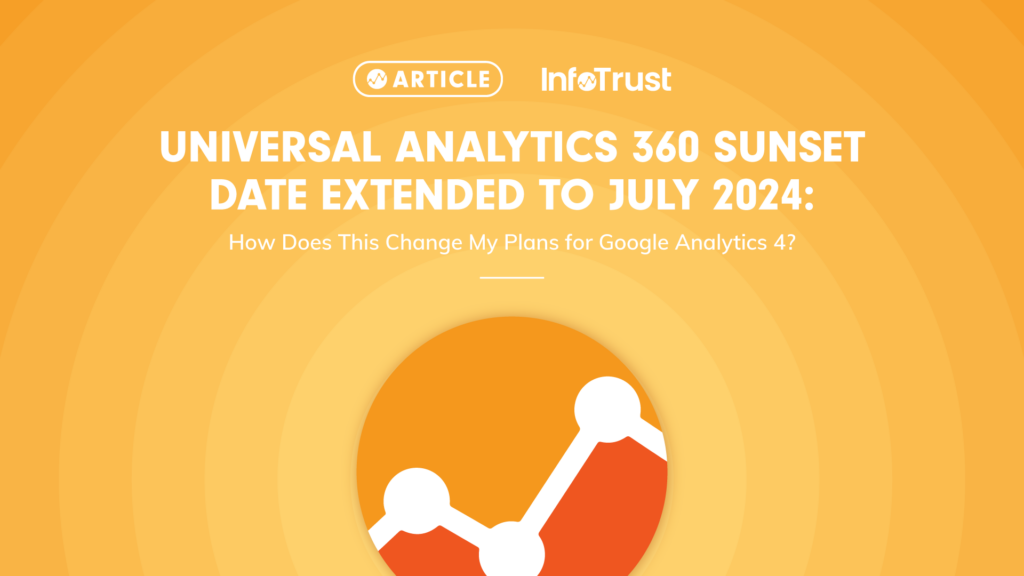Important Update as of October 27, 2022
Google announced that Universal Analytics 360, the enterprise platform, will have the sunset date extended from October 2023 to July 2024 where Google will stop processing data for Universal Analytics 360 (UA 360) properties exclusively as it shifts focus entirely to Google Analytics 4 (GA4) and Google Analytics 4 360. In addition, user access to UA 360 properties will be changed to ‘read only’ until the final turn down of the platform (Google has not indicated exact timing), and there is no change to the sunset date of July 2023 for standard/free Universal Analytics (UA) properties. This blog post outlines how you can adopt this extended date to continue the momentum and adoption of GA4 today, taking steps to preserve UA data, and training your organization to adopt GA4 as your enterprise analytics platform.
You may be asking, why is Google changing the sunset date? Or, will they truly ever sunset Universal Analytics? The good news is that Google is providing more time now to ensure organizations properly deploy and adopt GA4 360 and we have outlined a plan below to ensure you are fully equipped to migrate to the new future of Google Analytics—GA4.
Summary
Google recently announced that they will be sunsetting Universal Analytics (UA),—the current iteration of Google Analytics—in 2024. All standard UA properties will stop processing new data in the second half of 2023, with the user interface shutting down in 2024 sometime, at least 6+ months later according to Google. This blog post outlines how you can prepare for the future of Google Analytics 4 (GA4) by migrating from UA to GA4, taking steps to preserve your historical analytics data, and training your organization to adopt GA4 as your enterprise analytics platform.
It’s official: Google announced it is eliminating UA with actual dates. You may be asking questions like, “What’s the difference between UA and GA4?“; “What happens to my UA data?”; “What do I need to do for GA4 to replace UA?”; and “Any workarounds?.” While this news may be shocking to some, the good news is that Google is providing more than a year’s heads-up, and we have outlined a plan below to ensure you are fully equipped to migrate to the new future of Analytics—GA4.
The Facts (That We Know as of October 2022)
On March 16, Google made an official announcement that Universal Analytics will be going away and will stop processing data in 2023 and all access to the UA user interface in 2024, as it continues to invest in GA4 as the future of analytics. However, there are some nuances to keep in mind (or consider) for those who are using Google Analytics 360, the enterprise version of GA vs. non-GA360 users. Here is what we know:
- UA standard/free properties will stop processing data in July 2023 – no change.
- UA properties will stop processing data in July 2024 for 360 properties.
- 360 features in the UI will still be accessible as long as the UI is accessible. For example, unsampled data exports and more than 20 custom dimensions will remain.
- It is unclear when the UI will be inaccessible for 360 properties, but we understand it to be until July 2024 as well – aligned with the date data will stop processing. UA standard/free properties will be accessible for 6 months post their sunset date of July 2023, however.
- GA4 360 (the enterprise version of Google Analytics 4) is available today, but we recommend clients consider switching to GA4 360 now as you can preserve UA 360 properties and features for a longer duration, and there are advantages with GA4 360 licenses and especially with the elements that will be a factor in pricing GA4 360, which is based on event volume.
- Google has indicated their product team is building tooling for Clients to move historical Universal Analytics data into Data Studio. This will enable Clients to fully access historical data going forward, however we at InfoTrust also propose a T-ETL-T approach – see below.
What Can I Do to Preserve My UA Data and Be Ready for Google Analytics 4?
UA is a separate set of properties than GA4, so any usage of UA including the interface or exported data and/or downstream systems leveraging UA data will need to be rebuilt/recreated. This is why it’s critical to begin dual-tagging your website with GA4. There are solutions, however, to preserve your UA data long-term, and strategies to adopt GA4 as your new source of truth.
In short, we recommend focusing efforts on a T-ETL-T approach:
The T-ETL-T – Tag, Extract, Transform, Load, Train – Approach
- Tag GA4 on your assets now (dual-tag, do not remove UA). For more information about the importance of dual-tagging your site, check out our on-demand webinar: Why You Should Deploy GA4 Now.
- Extract your UA data on a daily automated process ASAP to preserve all historical data in BigQuery or another data warehouse.
- Transform this exported data to recreate metrics that won’t be in GA4 that are available today like ecommerce conversion rate or any session-based metrics.
- Load the exported UA data into dashboards with new data sources of your data warehouse housing this data to allow for decoupling of reliance on UA interface. Interested in learning more? Check out our on-demand webinar on how to rebuild your dashboards in GA4.
- Train your organization for migration to GA4 by mid-2023 and/or how to access exported, transformed, and loaded data from UA in the meantime.
The Evolution of Web Analytics and How GA4 Is Different Than UA
Millions of businesses rely on services like Google Analytics to understand their customers and optimize their web experiences. Over the years technology has evolved and websites have become more complex, which has led to major advancements in the data analytics space. We’ve outlined some of the significant events that have impacted the industry below.
Where It All Began: The First Analytics Solutions Appear
At first, most URLs hosted a single HTML file of plain text. As sites added images, audio, and video, browsers had to make HTPP requests per page visit. Caching didn’t show up on log analyses and as demand grew, new solutions offered tracking of more than page views.
Where We’re At: The Birth of Google Analytics
In the late 1990s, it could take up to 24 hours for a large company to process its website data. Urchin provided data processing in little as 15 minutes and quickly became the top analytics provider, working with major web hosts and 1 in 5 Fortune 500s. In 2005, Google acquired Urchin for $300 million. Built as a hosted analytics solution heavily focused on quantitative data, Google Analytics was tied in directly with Google’s web marketing offerings and offered in-depth tag-based data. Universal Analytics was introduced by Google in 2012 and enabled tracking of users across multiple devices and platforms by assigning user IDs. Approximately 28 million active websites use Google Analytics.
Where We’re Going: Google Analytics 4 (GA4)
In October 2020, Google Analytics 4 (GA4) was introduced. It was designed to combine app and web analytics in a single platform and focused on user privacy without compromising insights. Google’s Universal Analytics will shutdown on July 1, 2023. Currently there is no direct upgrade path from Universal Analytics to GA4, and no method to transfer historical data. That’s why you need an analytics partner to help your organization make the switch.
The InfoTrust team is here to support you and your enterprise analytics needs during this migration journey. Please let us know how we can help on our next call.
Download a copy of our infographic on the evolution of web analytics and how GA4 differs from Universal Analytics.



